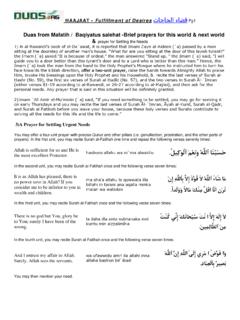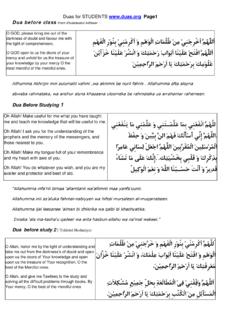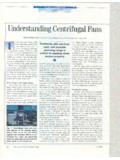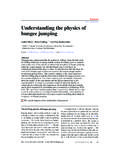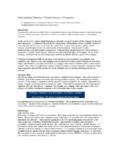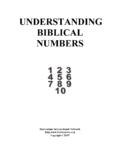Transcription of A step by step guide to learning how to Understanding ...
1 ReadA step by step guide to learning how to Understanding TajweedBook INTRODUCTION TO Q READ 2 .. 1 ARABIC NUMBERS .. 3 STOPPING SIGNS .. 4 SAJADAT OF TILAWAT QUR AN .. 7 DIVISIONS IN THE QUR AN .. 9 SAMPLE OF A QUR AN PAGE .. 11 TABLE OF CHAPTERS IN THE QUR AN .. 12 SOUND ORIGINATION - MAKHARIJ POINTS .. 15 SOUND ORIGINATION LIP LETTERS .. 16 SOUND ORIGINATION TONGUE LETTERS .. 17 SOUND ORIGINATION THROAT LETTERS .. 19 HURUF UL MUQATTA AT .. 20 QUALITIES OF LETTERS SIFAAT AL HUROOF .. 24 GHUNNA .. 26 RULES OF NUN SUKUN AND TANWEEN .. 28 RULES OF NUN SAKIN AND 29 IDGHAAM .. 30 IDH-HAAR .. 34 IQLAAB or QALB.
2 35 IKHFAA .. 37 EXERCISE .. 39 SIMPLE SUMMARY OF THE RULES OF NUN SAKIN AND TANWEEN .. 40 RULES OF MEEM SAKIN .. 41 QALQALA .. 43 RULES OF LAAM .. 45 RULES OF RAA .. 46 INTRODUCTION TO Q READ 2 Q READ 2 is the follow up to Q READ 1 and completes the basic rules for recitation of the Qur an with the focus on tajweed . Page 1 Before starting this book, the student should have finished Q Read part 1 and now practicing reciting the Holy Qur an. Q Read 2 begins with recapping on the rules of stopping and a basic introduction to the divisions in the Qur an and Arabic numbers. It follows with the all-important rules of tajweed .
3 Importance of reciting the Qur an correctly Allah also says in the Qur an ..and recite the Qur an as is taught to be recited (lit. with tarteel ). Qur an reading is the recitation of the Qur an according to tajweed & tarteel as taught by the Prophet Muhammad (pbuh). What is tarteel? When asked about the meaning of tarteel, Imam Ali (pbuh) replied: It means that the Qur an should be recited with tajweed and with due observance to the rules of waqf (pausing or stopping at the end of the verse). What is tajweed ? tajweed simply means to recite every letter correctly from its proper origin of pronunciation together with the attribute of its accompanying letters.
4 Just as in any other language, we learn to pronounce the letters and words : in English we learn ph stands for f and not p as in phone/fone and not pne ..similarly in the Arabic language, we also have to learn the proper pronunciation of letters and words which we term tajweed . Thus as a repeated example, the word qalb (with Q) means heart , if read kalb (with K) will now mean dog. tajweed also means to improve and to make better . The recitation and pronunciation of every letter of the Qur an from where the sound is supposed to come with its proper characteristics such as lengthening (isti laa), shortening (istif l), thinning (tarqeeq), thickening (tafkheem) and other phonetic rules such as absorbing/merging (idghaam), pronouncing clearly (idh-haar), changing (iqlab) and hiding (ikhfa).
5 Therefore we could say: tajweed of the Qur an is the knowledge and application of the correct rules of recitation so that the reading of the Qur an is as close as possible to the recitation of the Prophet Muhammad (pbuh). Page 2 ARABIC NUMBERS 1 2 3 4 5 6 7 8 9 01 Although Arabic language is read from right to left, Arabic numbers are read from left to right (as English numbers). For example: 92 = Not 29 145 = Not 541 Write the following numbers in Arabic: 2 = _____ 786 = _____ 9 = _____ 103 = _____ 41 = _____ 2691 = _____ 38 = _____ 3074 = _____ Write the following numbers in English: = _____ = _____ = _____ = _____ = _____ = _____ Page 3 STOPPING SIGNS This chapter is a recap from Q Read 1.
6 It is important to know the correct points at which to stop or continue during recitation in order to not change or distort the meaning of the ayaat. In the Qur an there are some signs or punctuation marks called waqf or in plural wuqoof . These are found in the middle or the end of ayaat and give us an indication of whether stopping/pausing is permitted or not. The most common waqf is: o : End of an aya STOP Sometimes the following letters are placed on the O or in the middle an aya to indicate various rules of stopping Compulsory stop Otherwise meaning is changed Stop End of a section Should stop End of a sentence Better to stop Can stop or continue Must continue, can take a breath Must continue, can take a breath Must continue.
7 Can take a breath Better NOT to stop Stop at the first or the second but not at both Better to stop but permissible to continue Better to continue but permissible to stop Page 4 STOPPING ON WORDS Whilst signs are helpful in showing where to stop, pause or continue, this topic will recap on what a break in recitation should sound like. Below is a brief recap of what was covered in Q Read 1. If further explanation or examples are required, please refer to Q Read 1. As mentioned in Q Read 1, there are 5 kinds of stopping or pausing: 1) fatha ( ) , kasra ( ) , dhamma ( ) , kasra tanween ( ), dhamma tanween ( ) vowel is read as a sukun.
8 O o 2) When the word ends with a letter that has a fatha tanween ( ) followed by or , The letter will be recited as a long vowel fatha (2 counts) o Page 53) If the word ends with a ta marbuta ( ), it is changed to a haa with a sukun. o 4) If the word ends with a sukun ( ) , it stays the same. o 5) If the word ends with a long vowel ( , , ) , it stays the same.
9 O Page 6 SAJADAT OF TILAWAT QUR AN There are 14 places in the Qur an where sajadat is to be performed. 4 are wajib and 10 are mustahab. There are 4 wajib sajadat: On hearing or reciting any of the following 4 ayaat, one must perform a sajda. It is not necessary to face qibla, or be in wudhoo. The 4 wajib sajadat are: Suwer Aya Juz 32. As Sajda (The Adoration) 15 21st 41. Hameem Sajda 38 24th 53. An Najm (The Star) 62 27th 96. Al Alaq (The Clot) 19 30th MNEMONIC: When a star 53 is born96 do 2 sajda s32 & 41 There are 10 mustahab sajadat: On hearing or reciting the aya, it is recommended that one performs a sajda; it is recommended and not wajib.
10 The 10 mustahab sajadat are: Suwer Aya 7. Al A raf (The Elevated Places) 206 13. Ar Ra ad (The Thunder) 15 16. An Nahl (The Bee) 50 17. Bani Israil (The Children of Israil) 109 19. Mariam (Mary) 58 22. Al Haj (The Pilgrimage) 18 25. Al Furqan (The Criterion) 60 27. An Naml (The Ant) 26 38. Saad (Saad) 24 84. Al Inshiqaq (The Bursting Asunder) 21 I heard thunder13 & looked up7 where I saw an explosion84 it was Israa17 which I had read about in the furqan25. The bees16 and ants27 were scared & Maryam19 went to hajj22 to seek the secret38. Page 7 Although there is no need for any recitation, it is recommended to recite the following in sajda: Indeed there is no god except Allah There is no god except Allah, I believe and have faith in Him There is no god except Allah, My servitude and bondage is to Him To You my Lord I prostrate in servitude and bondage neither with pride nor arrogance.








